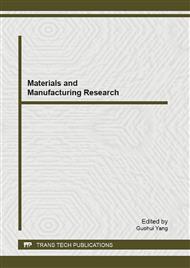p.153
p.158
p.165
p.169
p.174
p.178
p.182
p.188
p.194
Performance of Granular Media from Blast Furnace Slag on Beer Wastewater Treatment
Abstract:
In order to improve utilization ratio of blast furnace slag (BFS), the study used BFS, cement and building glue to make blast-furnace-slag granular media (BGM) in a non-sintered process. The characterization of BGM was analyzed by physical method, scanning electron microscopy (SEM) and D/max-rA X-ray diffraction (XRD). And the influence of hydraulic retention time (HRT) and air-liquid ratio (A/L) on the removal of average chemical oxygen demand (COD) and ammonia nitrogen (NH4+-N) were also investigated. The results indicated that the BGM presented high total porosity, large total surface area and low bulk and apparent density. The BGM reactor showed the good removal efficiency on COD and NH4+-N with HRT of 6 h and A/L of 5:1, which were above 86% and 90%, respectively. Overall, BGM showed good performance as wastewater treatment filter media in biological aerated filters (BAF), whose application is a promising way to use waste blast furnace slag.
Info:
Periodical:
Pages:
174-177
Citation:
Online since:
January 2013
Authors:
Price:
Сopyright:
© 2013 Trans Tech Publications Ltd. All Rights Reserved
Share:
Citation:


